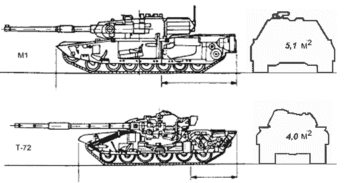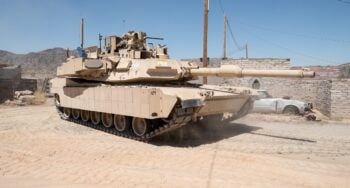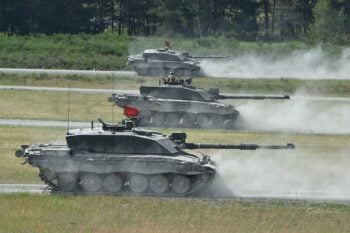SYDNEY J. FREEDBERG JR.

WASHINGTON – The dam has broken for main battle tanks, with Poland pledging to provide Ukraine small numbers of the massive armored vehicles and more nations expected to follow. Now for the hard part: getting Ukraine enough of these heavy tanks to matter — and then teaching Ukrainians how to use them, because Western war machines are very different from the Soviet-derived designs they’ve fought with since 2014.
Poland has pledged about a dozen German-built Leopard IIs, Finland has suggested a Europe-wide effort to send Leopards, and Britain is rumored to be sending ten of its home-grown Challenger IIs, but Ukraine’s top commander, Gen. Valeriy Zaluzhny, has said he needs 300. So the numbers are too small to matter much militarily — so far. What’s more, sending many small batches of different tanks is a logistical nightmare. Ukrainian support troops already have to make heroic efforts to maintain a hodgepodge of often-incompatible equipment, from Western tech to Soviet-era holdovers to captured Russian machines, all with different requirements for training, supplies, and spare parts.
But despite hot takes from Elon Musk and other commentators that drones and smart weapons make tanks obsolete “deathtraps,” the kind of cross-country offensive Ukraine plans for the spring still requires so-called main battle tanks — heavily armored, heavily armed, tracked and turreted vehicles designed for face-to-face combat. (Lighter vehicles can also play key roles, like the M2 Bradley and Marder, well-armed and fully tracked troop carriers being provided by the US and Germany respectively, or the AMX-10 RC, wheeled scout cars from France, but they can’t slug it out with the toughest foes like main battle tanks). So the challenge for Ukraine and its suppliers is to figure out what kind of tank they can field quickly and in quantity, and how to adapt the battle-hardened Ukrainian forces to best use them.
Yes, Ukrainian soldiers now have as much experience of tank combat as anyone in the world, but they’ll still face a steep learning curve with whatever type or types of tanks the West provides. To start with, modern Western main battle tanks, tipping the scales at over 60 tons, are much bigger than the Soviet-derived designs, weighing 40 to 50 tons, that Ukraine has used for years. And that size difference is just the most visible manifestation of a fundamentally different design philosophy that requires different training, tactics, supply, and maintenance.
The good news for Ukrainian tankers is their roomier new rides will boast better armor, greater comfort — critical to combat efficiency after long days in cramped machines — and better electronics. The bad news is the bigger Western tanks have a harder time hiding under cover, guzzle more fuel, and need a larger crew, four troops instead of three. Perhaps most problematic of all, at 55-plus metric tons, they are too heavy to safely cross many Ukrainian bridges. So not only tank crews, but commanders, planning staff, supply units, and maintenance troops will need to learn to use and support their new tanks properly.
East and West weren’t always so far apart. In World War II, the US and the USSR advanced their armored forces on largely parallel paths. Both standardized production on one affordable, medium-weight, good-enough design — the American M4 Sherman, widely used by all the Allies, and the Soviet T-34 — and built them, in a range of variants, by the tens of thousands. By balancing quality and quantity, the Allies outperformed the German panzer force, which developed small numbers of ever-heavier machines, with big guns, thick armor, and an embarrassing tendency to break down, run out of gas, or, in the case of early Panthers, spontaneously burst into flame.
After the war, however, the common experience of being outgunned by the Nazis’ rare but scary “big cats” — the Panther, Tiger I, and Tiger II — drove the West and the Soviets in opposite directions. Western tanks grew ever bigger, heavier, more expensive, trying to emulate the guns and armor of the “big cats” but not their mechanical flaws. The Soviets doubled down on the wartime strategy of building more, smaller, and cheaper. (They also tried to make their tanks more robust and mechanically reliable, but that became less true over time as technology advanced and was always compromised by poor quality control). Most problematically, starting in 1963 with the T-64, the Soviets replaced the human ammo-loader with a more compact mechanical autoloader. That let them shrink their tanks still further — but the price was a more vulnerable ammunition storage system that, when hit, tends to blow the turret off like a jack-in-the-box and kill the entire crew.

Western tanks like the American M1 Abrams are much larger than Soviet-derived designs like the T-72 (via GlobalSecurity.org)
While economic nationalism in the West and design-bureau rivalries in the USSR led to a variety of competing designs, each camp converged around a common template.
Modern Soviet-derived designs weigh 38 to 48 metric tons (42 to 52 American tons), armed with a 125 mm smoothbore cannon, and manned by three soldiers (commander, driver, and gunner). All current Ukrainian and Russian main battle tanks are variations on this theme, albeit each has its own quirks. The groundbreaking T-64 turned out to be a mechanical mess, and its successor, the T-80, was similarly overengineered, but they happened to be built in Kharkiv, so they became the mainstay of the post-Soviet Ukrainian army, which further upgraded some as T-84s. Meanwhile the less potent but more reliable T-72 was built in vast numbers, mostly by a factory in the Urals, and repeatedly upgraded, and its much-modernized offshoot the T-90 is the cutting-edge Russian tank.
By contrast, “third generation” NATO main battle tanks weigh from 54 to 67 metric tons (60 to 74 US), use 120 mm smoothbore guns (except for the eccentric British Challenger), and require four crew (commander, driver, gunner, and loader). But the three most likely candidates for transfer to Ukraine differ in subtle yet significant ways.
What Could Ukraine Get?

Upgraded US Army M1 Abrams tank with Trophy Active Protection Systems (APS) and improved protection for machinegun operator. (Rafael photo)
The American M1 Abrams is the most numerous modern Western tank. While introduced back in 1980, it’s also in many ways the most modern. While thousands of M1s are now in mothballs, those still on active US service have undergone multiple major upgrades, driven by decades of combat in Iraq and strong Pentagon funding. Hundreds have even received Israeli-made Trophy Active Protection Systems to shoot down incoming anti-tank missiles. Unfortunately, all these add-ons have made the M1 the heaviest Western tank, with the latest version (M1A2 SEP v3) weighing in at almost 67 metric tons (73.6 US). Even more problematic for logistics is the M1’s engine: Unlike all other Western tanks, which use diesels, the M1 has a turbine, with high performance but appalling mileage, roughly three miles to the gallon offroad.
“Ukraine does need tanks, [but] the Abrams tank, in addition to being a gas guzzler, is quite challenging to maintain,” warned Laura Cooper, the Deputy Assistant Secretary of Defense for Russia, Ukraine and Eurasia, when she was asked last week about sending M1s and other heavy vehicles to Ukraine. “So we want to look across the board at the range of tank capabilities and see where we can all support Ukraine.”
Perhaps as a result of its extreme weight, mechanical complexity, and fuel demands, Abrams has not been widely exported, being bought only by a few Arab allies, Australia, and — as of last year — Poland, which makes it easier for the Poles to pass their Leopards along to Ukraine.

Three of the seven major variants of the Leopard II (Krauss-Maffei Wegmann graphic)
Abrams and Leopard are actually siblings separated at birth, both offshoots of a cancelled US-German program called MBT-70. Introduced in 1979, the Leopard II has become the most widely exported Western tank — in large part because the Bundeswehr downsized drastically after the Cold War and sold off tanks at fire-sale prices. With roughly 3,500 built and in service around the world from Canada to Singapore, Leopards have proven adaptable to all sorts of armies and are available in all sorts of variants and conditions. Ironically, however, Germany itself has only 225 of the tanks remaining and many of them, like other Bundeswehr equipment, have been poorly maintained. In 2021, the Germans began fielding the latest upgrade, the upgunned and uparmored Leopard II A7+, but most Leopards both in Germany and beyond are older models, with Turkey’s aging A4s suffering serious losses in Syria.

British Challenger IIs of the Queen’s Royal Hussars during an international competition in 2018 (US Army photo)
If the Leopard II fleet has been upgraded inconsistently, however, that still beats the final candidate, the British Challenger II, which hasn’t been upgraded at all. While it entered service more recently than the other two tanks, in 1998, the “Chally” has not received any major updates since, a growing worry for UK officials. The Challenger also presents a unique logistical headache in that its ammunition is incompatible with other Western tanks: While the caliber is the same, 120 mm, Challenger’s barrel is rifled while all the others are smoothbores. (There were complex historical reasons for this choice, but an upgrade to smoothbore is now underway). Finally, there just aren’t a lot of Challengers available: Less than 450 were ever built, the only export customer was Oman with 38, and the UK itself has only 227 left in service. So while the UK has been criticized for floating a token donation of 10 tanks, it can’t donate a strategically significant number without gutting its own force.
Still, there seems to be movement towards a tank transfer of some kind to Ukraine. A government official told Breaking Defense in a Thursday statement that “We are accelerating our support to Ukraine with the kind of next-generation military technology that will win this war. It is clear that battle tanks could provide a game changing capability to the Ukrainians and the Prime Minister told President Zelenskyy last week that the UK will provide whatever we can.
“The Prime Minister has tasked the Defence Secretary to work with partners in the coming weeks to discuss how we can go even further, and faster, on our support to Ukraine, including the provision of tanks.”
Other Western tanks that are, so far, not publicly under discussion for donation include the French LeClerc — the only European tank with an autoloader — and the Italian Ariete; both happen to be under 60 metric tons, closer to Soviet-style weights. But if Ukraine is to get enough heavy tanks to make a difference, without having to kludge together a force from multiple incompatible models, it’s easy to see why the MBT momentum in Europe seems to be for a coalition of willing donors to give Leopards.
No comments:
Post a Comment